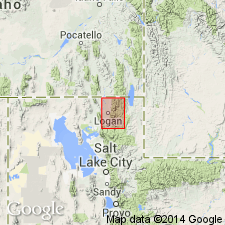
- Usage in publication:
-
- Cowley Canyon member
- Modifications:
-
- Named
- Dominant lithology:
-
- Limestone
- AAPG geologic province:
-
- Wasatch uplift
Summary:
Named as the basal member of the Wasatch group [no explanation for group rank given] for exposures in Cowley Canyon, Cache Co, UT on the Wasatch uplift. No type locality designated. Is a distinctive lithologic unit that at most outcrops is ooidal, stromatolitic, pisolitic or algal limestone with brown stromatolites in a brownish-gray matrix of compact limestone. Similar to and probably synchronous with Flagstaff limestone of the Wasatch plateau area. Section 83 ft thick measured in Cowley Canyon where the member unconformably overlies Garden City limestone of Ordovician age and underlies pebble and cobble conglomerate of the upper unnamed part of the Wasatch. Described in measured section as composed of (ascending): 1) basal massive stromatolitic conglomerate and breccia; 2) pebble, cobble, and boulder conglomerate from the Brazer and Wells, and possibly Madison formations with beds of grit and coarse-grained sandstone and lenses of stromatolitic limestone; and 3) massive stromatolitic limestone. Formed in a shallow lake subject to nearshore currents. Lake may have extended N-S from south side of Temple Peak, T12N, R3E to James Peak, T8N, R1E, and eastward into Randolph quad. Ranges from 0-83 ft thick. Mapped (geologic map) with Wasatch. Paleocene or Eocene age [age not clearly stated].
Source: GNU records (USGS DDS-6; Denver GNULEX).
For more information, please contact Nancy Stamm, Geologic Names Committee Secretary.
Asterisk (*) indicates published by U.S. Geological Survey authors.
"No current usage" (†) implies that a name has been abandoned or has fallen into disuse. Former usage and, if known, replacement name given in parentheses ( ).
Slash (/) indicates name conflicts with nomenclatural guidelines (CSN, 1933; ACSN, 1961, 1970; NACSN, 1983, 2005, 2021). May be explained within brackets ([ ]).

